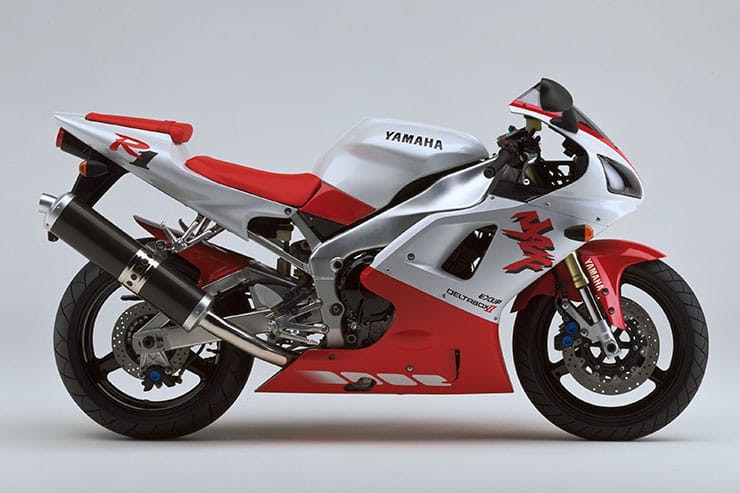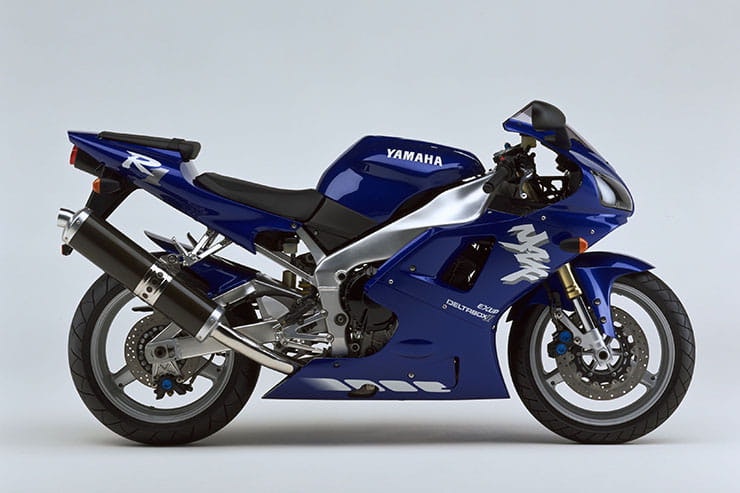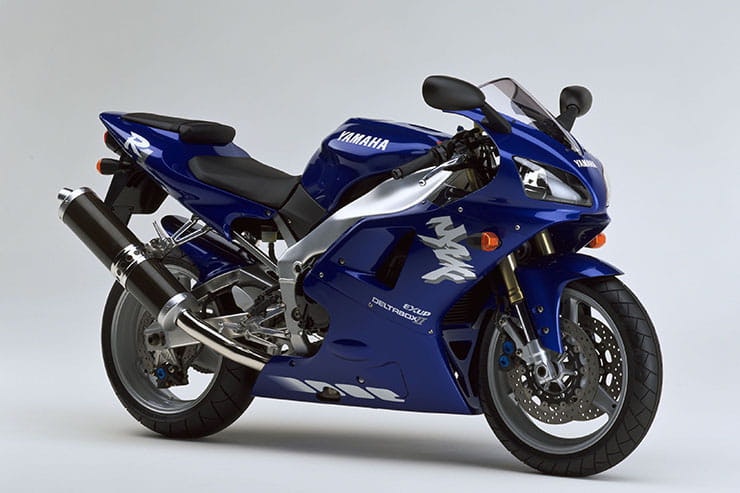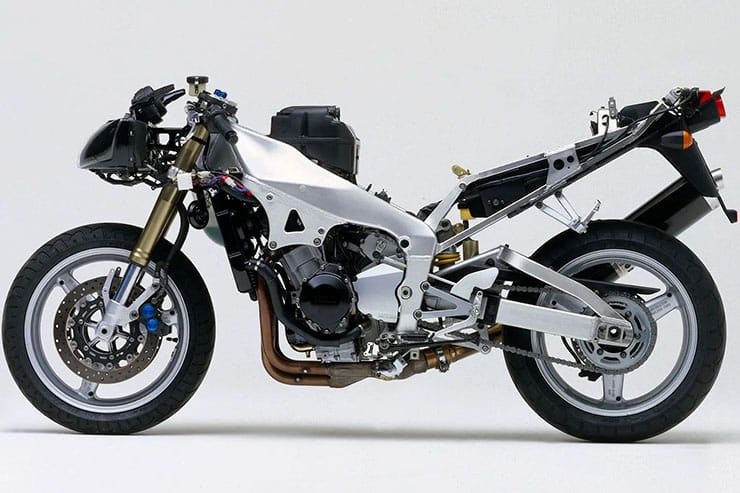Yamaha YZF-R1 (1998-2003): Review & Buying Guide
By Jim Moore
Bike journo for a quarter of a century
20.03.2023
Price: £6000-£9000 (mint) | Power: 148.8bhp | Weight: 177kg | Overall BikeSocial Rating: 4/5
Yamaha’s YZF-R1 is THE ultimate 1990s inline-four superbike. Faster, lighter, more powerful and agile than its rivals, the original 1998 4XV model represents the developmental apex of the genre for that decade. Now, 25 years on from its launch, first-model YZF-R1s (4XV) and their close descendants (5JJ and 5PW) have become the most desirable, sought after and collectable litre-class sports bikes of that era. And with good reason.
Honda FireBlade designer Tadao Baba coined the phrase ‘light is right’, siting minimal mass as being as critical to a sports bike’s overall performance as outright power. He was correct, of course, and Baba-san’s mantra became the blueprint for superbikes thereafter. Yamaha adopted the formula for its own ends (as did Kawasaki with its ZX-9R C1, launched just before the R1 in late ’97), sharpening and focussing the idea into its own big-bore sports bike, the YZF-R1.
What made the Yamaha so effective – and indeed still does – was not only its modest 177kg dry weight (5 kilos less than a ’92 Blade), or its class-leading performance (a claimed 148.8bhp), but its easily exploitable combination of the two. Early R1s did, however, gain a reputation for flighty front-end antics, particularly under hard acceleration or over uneven surfaces, but most owners found that fitting a steering damper curbed any inherent nervousness displayed by the Yamaha’s chassis.
A radical rethink regarding how a light, powerful superbike should be packaged allowed Yamaha to take ‘light is right’ to the next level. A short wheelbase is essential for agile handling but combining huge power with compact dimensions is a recipe for wheelies. And while monos are fun, they compromise forward drive. Yamaha’s answer was to shorten the motor’s length by stacking the gearbox upwards rather than horizontally behind the crank – a trick the firm’s engineers had already perfected with the XTZ750/TDM850 and TRX twins.
This redistributed the bike’s mass towards the front end and allowed the fitment of a longer swingarm, all within the confines of a minimal 1395mm wheelbase (10mm shorter than a ’92 FireBlade), resulting in nimble handling, rapid steering, maximum off-corner drive and minimal airborne antics from the front end (well, almost…). This combination of clever engineering, middleweight-sized dimensions and dominant performance left the opposition dead in the water.
The YZF-R1’s distinctive shark-like styling helped massively, too. Aggressive yet classy – especially in red and white which, although not as popular as blue when new, has become the must-have colour now – the R1 made 750s and even some 600s of the period look and feel bloated, ill thought out and, frankly, ancient in comparison. The R1 led the way in terms of braking too; its one-piece, 4-piston, ‘blue-spot’ calipers were the absolute last word in production brakes at the time.
Updates followed, of course, with increased power, even sharper styling and superior componentry – some to iron out the YZF’s perceived animalistic delivery that could intimidate less experienced riders – yet the model remained unmistakeably ‘R1’ up until 2004 when Yamaha gave it – the 5VY – a radical overhaul, mounting the silencers under the rear seat, under-bracing the swingarm and adding even more power (a claimed 172bhp). But in terms of usable, exciting modern classics that are set to continue increasing in value, 1998-2003 YZF-R1s remain hard to beat.
Yamaha YZF-R1 (1998-2003) Price
There are three distinct YZF-R1 models covering 1998-2003. The first, unveiled at the back end of 1997 and on sale from January ’98, is the 4XV. 1998 bikes were available in two colour options – red and white or Yamaha racing blue, the latter being the most popular at the time although that has now switched with red and white 4XVs currently commanding a premium over their more common blue variants (up to £500 more). Initial purchase price for the R1 was £9199.
The R1 kept its 4XV code for 1999, although updates were made to the spec including a longer gear lever linkage, reduced reserve tank capacity (down by 1.5 litres to 4L), and ignition tweaks to smooth out the power delivery. The red/white colour was dropped in favour of a more conservative red/white/black option and graphics were updated too. Purchase price was reduced to £8299.
4XV values: Rough £1500-£2500; Tidy £3500-£5500; Mint £6000-£9000
More updates followed in 2000, with the 5JJ model. Styling was tweaked – a sharper nose fairing, black wheels and titanium-finish silencer being the most obvious changes. Extra bracing around the headstock and swingarm pivot strengthened the frame, while upgraded forks and a stronger bottom yoke improved front end feel. Ignition timing, fuelling and the EXUP valve were all reworked, as were the front discs which were made thinner and lighter. Overall weight was reduced by 2kg, while the mechanical mods helped smooth delivery of the claimed 150bhp. New graphics given to the red/white/black and blue colour options. Purchase price £8899. 2001 5JJs received updated graphics.
5JJ values: Rough £1300-£2200; Tidy £3000-£4800; Mint £5000-£6000
A completely new YZF-R1 appeared for 2002 – the 5PW. New chassis, a fuel injected motor, and even more angular styling. Power increased slightly to 152bhp. More importantly, however, the 5PW’s impressive performance was made even easier to access than on previous models thanks to Yamaha’s ingenious fuel injection system featuring a vacuum operated sliding piston valve to match airflow to engine rpm. This created the feel of carbs, giving smooth, precise fuelling at a time when rival injection systems were often rudimentary and jerky. Colours graphite/black and red/white/black. Cost new, £8899.
5PW values: Rough £1800-£2400; Tidy £3500-£4500; Mint £5000-£6000
THE 1990s inline-four superbike; fast becoming a classic
Blistering performance (still) free from the sanitising interference of rider aids
Immensely rewarding to ride; still a weapon in the right hands
Many have been crashed and bodged ‘straight’. A keen buyer’s eye is required
You’ll pay a premium for a red and white 4XV; maybe as much as £500 more
Know what you’re buying – imports from certain markets can be heavily restricted and expensive to revert to full power
Yamaha YZF-R1 (1998-2003) Engine and Performance
The first YZF-R1 engine was most notable for its stacked gearbox, that afforded Yamaha more control over the bike’s centre of gravity, weight bias and handling characteristics. The basic engine layout is familiar Yamaha fare: an across-the-frame line-four topped by a DOHC head working through a five-valve-per-pot arrangement – three per inlet, two for exhaust.
Yamaha kept the unit’s width to a minimum by locating the camchain on the left side of the motor (the previous FZR/Thunderace motor featured a central cam tunnel). A smaller bore than the T’Ace (74mm instead of 75.5mm) further trimmed the engine’s width; a 58mm stroke produced a capacity of 998cc. Claimed output for the 4XV is 148.8bhp @ 10,000rpm and 79.9lb.ft @ 8500rpm. The basic architecture remained the same throughout the YZF-R1’s 1998-2003 run, although fuel injection was added to the 2002 5PW model, for which Yamaha claimed 152bhp@10,500rpm and 77.3lb.ft@8500rpm.
Yamaha YZF-R1 (1998-2003) Handling & Suspension
Early R1 handling can be described in three words: nimble, exciting, and flighty – an inevitable outcome given the bike’s modest weight, compact dimensions and explosive power delivery. On smooth surfaces (read racetracks) these Yamahas are sublime, but in the real world of poorly surfaced and often badly maintained A and B roads early R1s can become a handful, especially when subject to ham-fisted inputs. As a result, many owners fitted steering dampers.
Although fully adjustable, the stock suspension is unsophisticated by modern standards. Ride quality was reasonably plush when new, but any early R1 – regardless of mileage – will by now benefit from a suspension refresh. New oil, seals, more advanced cartridge fork internals, plus a shock respring and set-up is well worth the investment (budget between £500-£1000 depending on what level of refresh you decide on).
Yamaha tamed each subsequent model – while also increasing performance – so by the time the 5PW arrived in 2002 the R1 was a thoroughly polished package, delivering more than 150bhp with a sophistication unmatched by even Suzuki’s outstanding GSX-R1000.
Yamaha YZF-R1 (1998-2003) What to look for
Crash damage: R1s were hugely popular with racers (from club to national level) and trackday fanatics, so there’s a high chance any used example will have been dropped. Check for scuffed surfaces (metal and plastic), dented frames, cracked welds and out-of-true wheel alignment. An HPI check is recommended. Note that original 4XV plastics are no longer available.
EXUP valve: The exhaust powervalve needs servicing at least every two years (preferably annually) if it’s to continue opening and closing correctly. Remove carbon deposits, adjust cables and apply copper grease to moving parts.
Gearbox: R1s encourage wheelies which can take their toll on the gear engagement dogs. Get a test ride, drive hard in second – if it jumps out of gear, the dogs are most likely worn.
Engine: Generally robust if properly maintained. The cylinders – cast as part of the cases – can develop hairline cracks, so inspect thoroughly. Likewise, R1s can use oil; anything more than a litre per 1000 miles should cause concern. Throttle position sensors are a known issue; the tacho needle dropping to zero then back up again is a tell-tale sign. A genuine replacement is around £180.
Chassis bearings: Head bearings can suffer from ham-fisted wheelies. Likewise, the rear suspension linkages weren’t generously lubricated from new so will by now be in desperate need of a strip and regrease. A lengthy but essential job.
Originality: Highly prized, especially on 4XVs. Early 4XV end cans are proper carbon fibre – shortly into the run Yamaha changed this to a faux carbon material. Rear seat covers and numberplate brackets are especially hard to find.
Yamaha YZF-R1 (1998) Rivals
Honda CBR900RR FireBlade, 1998 | Approx Value: £2500-£50000
Power/Torque: 128bhp/68lb-ft | Weight: 180kg (dry)
The blueprint for ’90s inline-four superbikes. Hugely popular, but constant tweaks robbed subsequent models of personality; by 1998 the Blade was feeling its age – a generation behind the R1 in effect.
Kawasaki ZX-9R, 1998 | Approx Value: £2000-£3500
Power/Torque: 143bhp/74.4lb-ft | Weight: 183kg (dry)
A brilliant bike, sadly overshadowed by the R1. A better road bike than the Yamaha – roomier and more comfortable – and almost as exciting. If you want a ZX-9R go for the 2002-2003 F model which is notably better than the C.
Suzuki GSX-R1000K1, 2001 | Approx Value: £3500-£6000
Power/Torque: 160bhp/81.1lb-ft | Weight: 170kg (dry)
Faster, lighter and more powerful than the equivalent R1, but lacks the Yamaha’s style, finish and desirability. Gearboxes can be problematic and the nitrided finish on the forks is poor. Still packs a punch though, even 22 years on.
Yamaha YZF-R1 (1998-2003) Verdict
An appreciating modern classic that’s still hugely rewarding to ride, easy and pleasurable to work on and maintain. Crucially, YZF-R1s are still affordable – especially if you shop about. Originality is absolutely key to value because returning a molested or modified 4XV back to standard can be an expensive and tricky task. In terms of an investment and purity of design, an original 4XV is the pick of the bunch. If your budget can’t stretch that far for a minter, but you still want the early R1 vibe and ride a 5JJ ticks all the boxes. Alternatively, if performance and the ride is top of your wish list, a 5PW should be in your sights.
Yamaha YZF-R1 (1998) – Technical Specification
Looking for motorcycle insurance? Get a quote for this motorbike with Bennetts bike insurance



